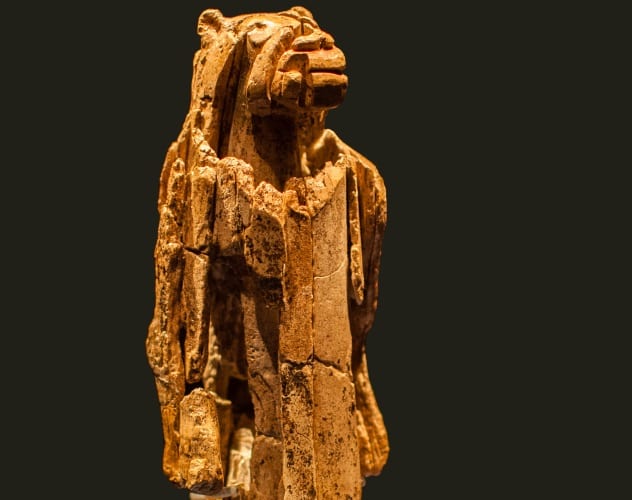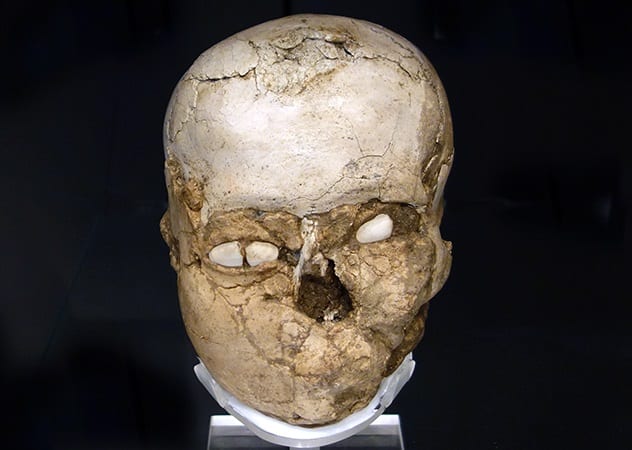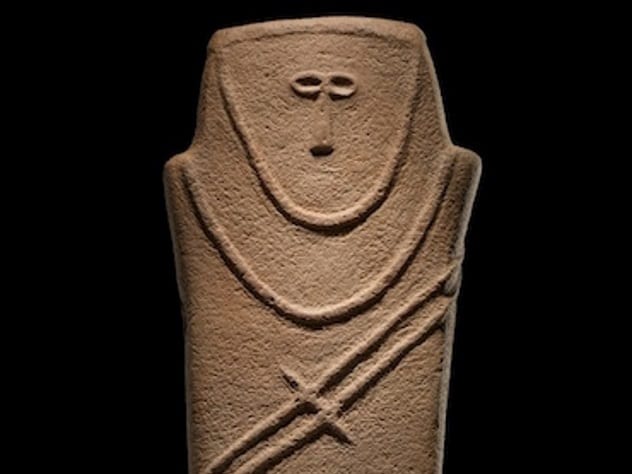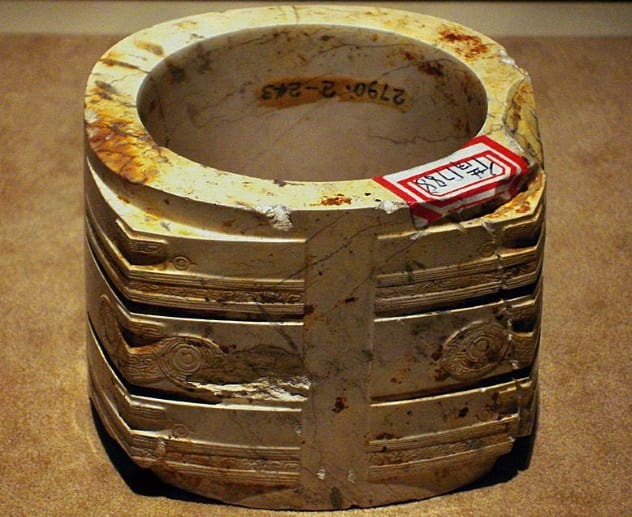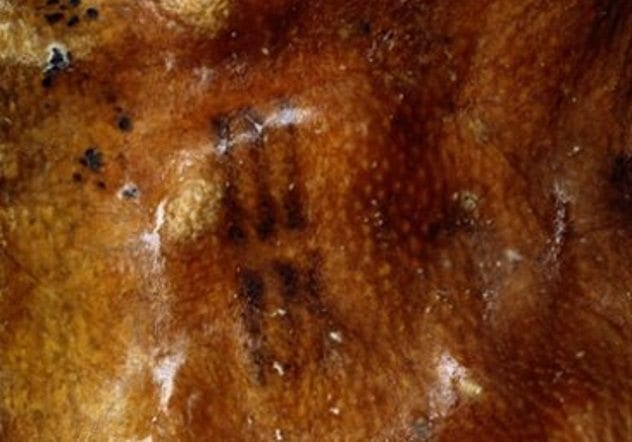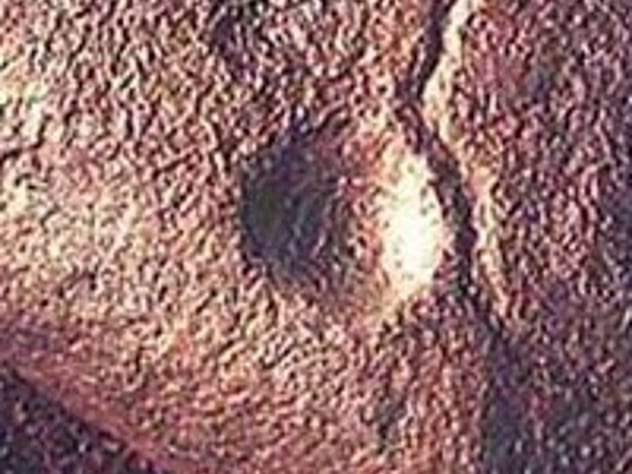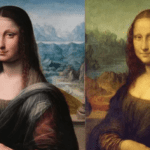From Salvador Dali and his surrealism to Michelangelo and his sculptures and, of course, the grand, gorgeous, awe-inspiring ceiling of the Sistine Chapel, that can move even the stiffest of us who “don’t get art,” we’ve been making art from a long time. It began likely as simple decorations for tools, rocks, or even the dead bodies of friends and loved ones. Grave design is art; face paint is art. Art is all around us, and it’s almost inescapable. Prehistoric humans actually made a lot of art, and a lot of different finds have helped us piece their stories together, telling us much about their lives and how they lived them. Here are ten prehistoric pieces of art and their stories.
10 Apollo 11 Stones
The Apollo 11 Stones are a group of seven stones, two of which used to be one single piece, that depict animals. The fascinating part about the Apollo 11 Stones is their sheer age, dated to around 25,000 BC. Why is this so important? Because of the progress of the human race at this point. This shows that by this point, humans were thinking a bit like us, making art and inscribing their daily lives into stone for us to find some 27,000 years later. These artifacts were discovered in the Apollo 11 Cave in Namibia.[2] The stones, etched with charcoal, ocher, and other substances, have taught us a lot about the people living at the time. The Apollo 11 Stones are named such because the success of the Apollo 11 landing was broadcasting on the radio soon after archaeologists made their discovery. Probably the most astonishing part is that within the cave, archaeologists uncovered evidence of about 100,000 years of human occupation, meaning the term “cave man” is very real, and this is how our ancestors survived the harsh, prehistoric world of the Paleolithic period. The Apollo 11 Stones are the oldest example of representational art found in Africa to date.
9 Venus Of Willendorf
The Venus of Willendorf is a figurine made out of limestone. Sources vary on its age, but most give a date range of 28,000 to 25,000 BC. So it’s from roughly around the same era as the Apollo 11 Stones, during the Paleolithic period. There are also later versions of the Venus of Willendorf, some coming from somewhere between 24,000 and 22,000 BC, and the carvings are generally of naked women, possibly depictions of a fertility goddess or possibly men paying their respects to women and their life-giving abilities.[3] The harsh reality of paleolithic life was that many mothers died to give birth to their children, a somber reminder of how far we’ve come and the sacrifices made by those before us to get us here. On the Venus of Willendorf, great attention was given to her breasts and pubic region, while the rest of the figure is relatively rudimentary, with the artist who created it spending very little time on limbs, the details of muscles, or anything else. This gives us an insight into the mind of the figurine’s creator. Dating the Venus figurines is particularly hard, because “prehistoric” means that the written word did not yet exist for these people, so researchers have to rely on inference, comparison with other objects, and, of course, radiocarbon-dating to pin down when these objects were actually created.
8 Lion Man
If you thought the Sphinx of ancient Egypt was cool, get a load of this: Lion Man is a carving made out of a mammoth tusk that dates back to an amazing 35,000 to 40,000 years old, making it an extremely ancient example of human art and likely a glimpse into the world of humanity’s first religions. The statue is of a person with a lion’s head, much like the Egyptian Sphinx (albeit in reverse), only from many thousands of years prior.[4] The sculpture stands 31.1 centimeters (12.2 in) in height and was carved with a simple flint sculpting tool back in ancient prehistory. In fact, it’s so old that its dating places it square in an ice age. Discovered in 1939 with a slew of other artifacts from the same people and period of history, Lion Man stands out from the rest as a truly fascinating work of prehistoric human art from the Paleolithic period. It proves that humans did not need to harness a writing system before their imaginations could dream up supernatural things, possibly even gods. Ivory carvings were prominent in the period, showing humankind’s tenacity to weather the crushing cold and still create art that fascinates and inspires us today.
7 Jericho Skull
The Jericho Skull isn’t just your average skull found from prehistoric times, perhaps with a bit of decoration from ocher or charcoal; it’s actually a completely artistic sculpture in the shape of a human being. The artwork is a plastered skull fascinatingly modeled on a real human being, making it one of humanity’s first portrait sculptures.[5] Shells were set into the orbital sockets to make for a white appearance that resembles human eyes. It’s tremendously intricate for the time period of 7200 BC, in the Neolithic period of human existence. Researchers have actually been able to use CT scans reconstruct the face of the man whose head would become the Jericho Skull. He lived approximately 9,200 years ago and had obviously endured some tragic experiences which altered the way his face looked, with some inconsistencies in his symmetry. The man’s nose had definitely been broken, and he’d suffered a head injury soon after birth, affecting the shape of his skull. Yes, life was still painfully rough at times, even 9,200 years ago. The Jericho Skull is held at the British Museum in London. The sculpture was found among others in the Jericho area of the West Bank, one of the longest continuous settlements of human existence, believed to have first been settled around 9000 BC.
6 Anthropomorphic Stele
The next item on the list is the anthropomorphic stele, and it hails from the city of Ha’il in Saudi Arabia. It’s a stele that resembles a human being. It’s a free-standing stone sculpture that’s been carved out to resemble a person standing and has been dated from sixth to fourth millennia BC. The structure isn’t alone, either; there have been plenty of sculptures of similar sorts found all around neighboring cities, dating back to the the pre-Islamic world of Saudi Arabia, and they all have a very interesting look on their faces, definitely unique to the culture and period. These artifacts were sculpted by various bands of hunter-gatherer tribes who lived in the region at the time, long before the rise of Islam. The people who built them were nomadic, the constantly changing climate forcing them to move around in search of a suitable habitat. It should be noted that the area was much more like a savanna at the time and not the sand-filled desert it’s known to be today, but the climate still shifted frequently. While it is uncertain why the stele was created by these people, it seems to have likely carried some religious significance, and with its somber face, it possibly adorned a prehistoric burial.[6]
5 Cong
The cong are jade pieces from ancient China. They are decorative objects used for religious ceremonies and burials.[7] The pieces are circular, sculpted into a round shape, with squared corners added around the edges, producing both a round and square shape at the same time. These pieces date back to the Liangzhu, a culture of Neolithic people who lived near modern-day Shanghai around the third millennium BC. These people had highly sophisticated tools with which to sculpt and left us many intricately carved finds. The cong themselves were cylindrical in shape, with an open, carved out center, and came with other pieces called bi, which were round discs that sort of resemble a weight you would put on a bench press bar and fit neatly inside. These enigmatic objects are still not very well-understood, but the time and painstaking process that were required to make them show the dedication these people had for them and that they were of great significance to the ancient people of China.
4 The Hall Of The Bulls
The Hall of the Bulls is a section of the Lascaux cave near the village of Montignac, France, and it contains paintings of animals that are not only amazingly detailed and stunningly beautiful but powerfully indicative of the imagination and abilities of the people who created them. This is essentially the Sistine Chapel of the Paleolithic period, in that the artists planned and plotted tirelessly to adorn this cave with the most perfect animal paintings the world had ever seen. This isn’t your rudimentary cave painting here; these are gorgeous walls, covered with various depictions of animals, mainly bulls and bison.[8] The paintings are estimated to have been created between 16,000 and 14,000 BC in the cave, which lies in a rural part of Southwestern France. One of the murals spans a massive 3.5 meters (11.5 ft) wide, making it much larger than the usual cave painting we’re used to seeing in photos. The elegance of this artwork, considering the time period, is nothing more than mind-blowing, especially when we consider that these people lived short, brutal, often cold, often painful lives but still managed to find it within themselves to celebrate the beauty of existence and what was important to them.
3 Prehistoric Tattoos
Tattooing is actually, contrary to what your mother wants you to believe, one of humankind’s oldest art forms. Tattoos date back to ancient history and even prehistory, though ancient tattoos aren’t always preserved because of the nature of the human body and how flesh decays and breaks down after death. Tattooing the flesh actually spans all the way back to Neolithic times and has been revered in cultures worldwide for its deep, profound religious and cultural significance to peoples all over the globe. Tattoos have turned up on mummies and bog bodies the world over. A notable example is the Otzi the Iceman, who died in the Swiss Alps in around 3300 BC and had multiple tattoos (some of which are pictured above).[9] Tattooing back then required a lot more of a personal commitment than it does today, without the use of machines and electricity, and even the ink itself was a mixture of blood and pigment, much more difficult than what today’s manufacturing processes yield. This shows the dedication and significance of tattooing in the prehistoric era, namely the Neolithic period.
2 Stonehenge
Stonehenge is one of the most famous prehistoric works of art in the world. It’s a circle of massive stones that seem to have been designed as a place of worship, religious ceremony, and absolute significance in the times of prehistory. Stonehenge was actually built over the course of centuries, starting at around 3000 BC.[10] This massive structure is like the pyramids of Egypt in England, and it boggles the mind that tribes of the Neolithic period were able to accomplish its construction. It all began around 8000 to 7000 BC, when early humans started erecting wooden pine structures and digging ditches near the area. Then, over time, people thousands of years down the road began setting stones up atop one another, forming a massive wall-like structure, the perimeter of which forms a circle. There are large stones in the middle, and all of the stones in the structure were painstakingly pounded out smooth by hammers. Parts of the Stonehenge region were actually used for burials as well, where earth was dug out and special care was given to bury the dead.
1 Bhimbetka Cupules
While not necessarily as intricate or aesthetically stunning, the Bhimbetka cupules definitely take the top of the list of prehistoric works for their sheer age. The site at Bhimbetka in India contains many cupules, which are small, hemispherical holes dug into rock.[11] There are paintings on the walls of the cave that date to around 30,000 years old, but the main star of the show are the cupules, which reportedly date to at least 290,000 BC. Some have speculated that they could date as astonishingly far back 700,000 BC. That’s right, these spherical markings may predate humanity. The site alone covers hundreds of thousands of years of human history inscribed on its walls. For eons, people have sought safety here, shelter to cook food and escape the harsh world of nature. Inscribed on these walls, one might say, is the entire history of humanity, from before there were written words until well after. The site, and the rest of the items on this list, are surely a testament to how far we’ve come as a species and how far we can go if we dare to imagine future worlds that are far greater than the one we happen to inhabit now and strive for them. I like to write about dark stuff, history, and weird, unusual things.


